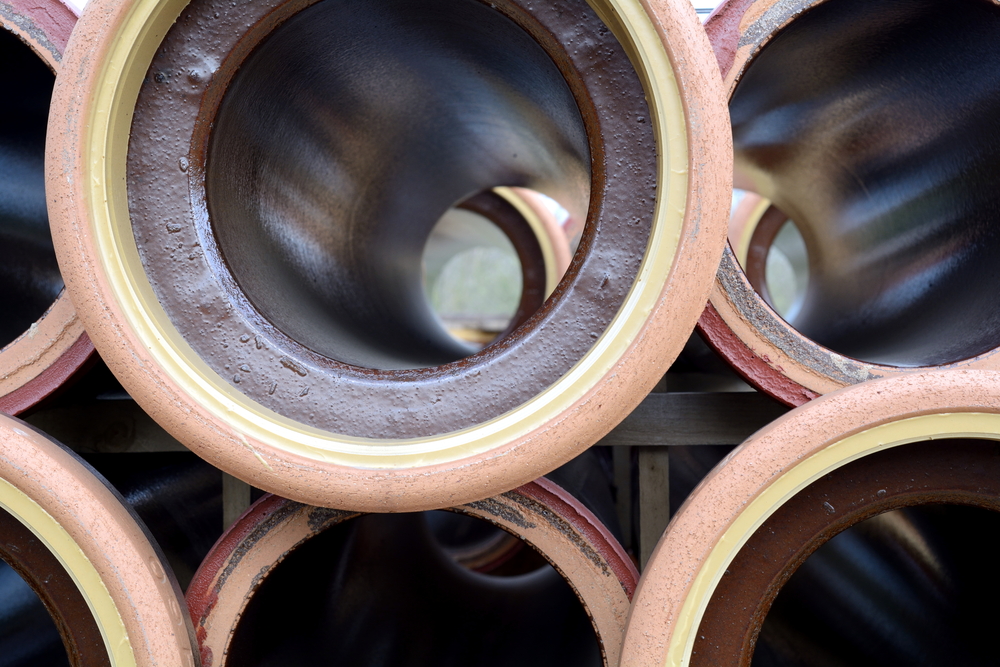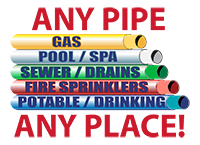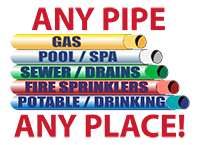
San Diego Plumbing & Pipelining is a trusted name in San Diego for all your sewer line repair needs.
Maintaining your sewer pipes is crucial to preventing severe plumbing issues that disrupt your daily life. Clay sewer pipes, while durable, can develop problems over time that require professional attention.
Our experienced team is here to provide reliable solutions to keep your plumbing system in top condition.
Clay sewer pipes have been used in plumbing for centuries due to their durability and resistance to chemical corrosion.
However, they have challenges. Common issues such as cracking, root intrusion, and blockages can lead to significant problems if not addressed promptly.
Understanding Clay Sewer Pipes
What Are Clay Sewer Pipes?
Clay sewer pipes, also known as terracotta pipes, have been a staple in plumbing systems for many years. Made from natural clay and fired in a kiln, these pipes are known for their durability and resistance to chemicals found in wastewater.
They were widely used in older homes and are still in many plumbing systems today.
| Feature | Description |
| Material | Natural clay fired in a kiln |
| Other Names | Terracotta pipes |
| Common Use | In older homes, traditional plumbing systems |
| Advantages | * Durable and long lifespan * Resistant to chemical corrosion from wastewater * Eco-friendly material |
| Disadvantages | * Susceptible to cracking and breakage due to age, ground movement, or tree root intrusion * Vulnerable to root intrusion that can cause blockages and further damage * Heavier and more challenging to install compared to modern materials |
Common Problems with Clay Sewer Pipes
Cracking and Breakage
Clay sewer pipes are prone to cracking and breaking due to ground movement, heavy loads, and age-related wear and tear. These cracks can lead to leaks and significant structural damage if not repaired promptly.
Root Intrusion
Tree roots are naturally drawn to the moisture in sewer pipes. Over time, they can penetrate clay pipes through small cracks or joints, causing blockages and severe damage.
Pipe Corrosion and Deterioration
Although clay pipes resist chemical corrosion, they can deteriorate over time due to physical wear and environmental factors. This deterioration can lead to blockages and reduced pipe integrity.
Blockages and Backups
Clay pipes can become clogged with debris, grease, and other substances, leading to blockages and sewage backups. Regular maintenance and timely repairs are essential to prevent these issues.
Signs You Need Clay Sewer Pipe Repair
Visible Signs of Damage
Sinkholes or Depressions in the Yard: Sinkholes or depressions in your yard can indicate a sewer pipe leak or collapse, requiring immediate attention.
Wet Spots or Water Pooling: Unexplained wet spots or water pooling in your yard may signal a leak in your clay sewer pipe.
Indoor Indicators
Frequent Clogs and Slow Drains: If you experience frequent clogs or slow drains, it could be a sign of a blockage or damage in your clay sewer pipe.
Unpleasant Odors: Sewage odors in your home or yard strongly indicate a sewer pipe issue that needs to be addressed.
Gurgling Noises from Plumbing Fixtures: Gurgling noises from your sinks, toilets, or drains can indicate a blockage or air trapped in the sewer system.
Our Clay Sewer Pipe Repair Services
Inspection and Diagnosis
Video Camera Inspections: We use advanced video camera inspections to accurately diagnose the condition of your clay sewer pipes and identify any issues.
Leak Detection Techniques: Our leak detection methods help pinpoint the exact location of leaks, allowing for targeted and efficient repairs.
Repair and Replacement Options
Traditional Trenching Methods: For severe damage, traditional trenching methods may be necessary to replace pipe sections.
Trenchless Repair Techniques: Trenchless repair techniques, such as pipe lining and bursting, offer minimally invasive solutions that avoid extensive digging.
Pipe Lining (CIPP): Cured-in-place pipe (CIPP) lining involves inserting a flexible liner coated with resin into the damaged pipe, which hardens to form a new pipe within the old one.
Pipe Bursting: Pipe bursting replaces old pipes by pulling a new pipe through the existing one, fracturing the old pipe, and replacing it simultaneously.
Advantages of Trenchless Technology
Minimally Invasive: Trenchless technology requires little to no digging, reducing disruption to your property and minimizing repair time.
Cost-Effective: Trenchless methods are often more cost-effective than traditional repairs because they avoid extensive excavation.
Durable and Long-Lasting Solutions: Trenchless repairs provide durable, long-lasting solutions that can extend the life of your sewer system.
The Repair Process
Initial Consultation and Assessment
Detailed Evaluation of the Problem: We start with a comprehensive evaluation of your sewer system to understand the extent of the damage and determine the best repair approach.
Personalized Repair Plan: We create a customized repair plan tailored to your specific needs based on our assessment.
Preparation and Excavation (if necessary)
Site Preparation: If excavation is necessary, we prepare the site carefully to minimize disruption and ensure a smooth repair process.
Execution of Repairs
Step-by-Step Process for Chosen Repair Method: We execute the repair method selected, whether it's pipe lining, pipe bursting, or another technique, with precision and efficiency.
Post-Repair Inspection and Testing
Ensuring the Effectiveness of the Repair: After the repairs are complete, we conduct thorough inspections and tests to ensure the repairs are effective and your sewer system is functioning correctly.
Follow-Up Video Inspections: We offer follow-up video inspections to monitor the condition of your repaired sewer pipes and catch any potential issues early.
Why Choose San Diego Plumbing & Pipelining for Your Clay Sewer Pipe Repair Needs
Choosing the right plumbing company can make all the difference when faced with clay sewer pipe issues.
At San Diego Plumbing & Pipelining, we understand the unique challenges these pipes present and are committed to providing exceptional service throughout the entire repair process.
Here's why we should be your trusted partner for clay sewer pipe repair:
Experienced and Skilled Technicians
Certified and Trained Professionals: Our team comprises highly trained and certified professionals. They possess the expertise and dedication to tackle even the most complex clay sewer pipe repairs.
Their experience ensures they can accurately diagnose the problem and recommend the most effective solution for your situation.
State-of-the-Art Equipment
Advanced Tools and Technology: We invest in cutting-edge technology to ensure accurate diagnostics and efficient repairs.
Our advanced tools allow us to pinpoint the exact location and nature of the problem with your clay sewer pipes.
This precision minimizes unnecessary excavation and streamlines the repair process.
Customer Satisfaction Guarantee
Testimonials and Reviews: We are committed to your complete satisfaction.
Our positive customer testimonials and reviews speak volumes about the quality of service we provide.
We stand behind our work and ensure your clay sewer pipe repair is completed to the highest standards.
Preventative Maintenance Tips
Just like your car needs regular maintenance to run smoothly, your clay sewer pipes benefit from preventative care.
Simple steps can significantly extend the lifespan of your clay sewer system and prevent costly repairs down the road.
Here are some key preventative maintenance tips:
Regular Inspections
Scheduled Maintenance Checks: Regular inspections and maintenance checks can help identify and address issues before they become significant problems. Learn about our investigation services.
Schedule regular inspections with a qualified plumber, ideally every 2-3 years. These inspections can identify minor issues like cracks or early signs of root intrusion before they escalate into major problems.
Early detection allows for prompt and often less expensive repairs.
Proper Usage Practices
Avoiding Flushing Harmful Substances: Avoid flushing items like grease, wipes, and non-biodegradable materials that can cause blockages and damage your sewer pipes.
Cooking grease can solidify and create blockages within the pipes. Let grease cool and solidify before discarding it in the trash.
Invest in drain strainers to catch hair and other debris contributing to clogs.
Root Management
Landscaping Tips to Prevent Root Intrusion: Plant trees and shrubs away from sewer lines to prevent root intrusion. Use root barriers to protect your pipes.
Root barriers can be installed around existing trees to prevent them from encroaching on your sewer pipes.
Consult a professional to determine if root barriers are a suitable solution for your situation.
Contact Us For San Diego Clay Sewer Pipe Repair Today!
If you suspect issues with your clay sewer pipes, don't wait for the problem to worsen. Contact San Diego Plumbing & Pipelining today for expert clay sewer pipe repair services.
We offer free estimates and are available 24/7 for emergency repairs. Contact us to schedule an inspection or learn more about our services.
Service Areas
We proudly serve San Diego and the surrounding regions, providing top-quality plumbing and pipelining services. Check out our service capabilities and see why we are the trusted choice for clay sewer pipe repair in San Diego.
Timely repairs are crucial to maintaining a healthy plumbing system. Don't hesitate to contact San Diego Plumbing & Pipelining for all your sewer pipe needs. We are here to help you every step of the way!
Clay Sewer Pipe FAQs: Keeping Your Home's Plumbing Healthy
Clay sewer pipes were once a common choice for homes in San Diego. While durable, they can present challenges for homeowners. Here are answers to some frequently asked questions about clay sewer pipes:
1. How can I tell if I have clay sewer pipes?
Homes built before the 1950s likely have clay sewer pipes. Visual inspection of the pipes during basement renovations or crawlspace repairs can confirm the material. Additionally, plumbers can utilize video camera inspections to identify the type of sewer line material.
2. What are the signs of trouble with clay sewer pipes?
Several signs can indicate problems with your clay sewer pipes:
- Slow drains and frequent clogs: This could be caused by debris buildup, root intrusion, or a collapsed pipe section.
- Sewer odors inside the house can indicate a leak or break in the sewer line, allowing sewer gases to escape.
- Gurgling sounds from drains: This can be caused by air trapped in the line due to a blockage or a break.
- Settling or sinking in your yard could be a sign of a collapsed clay sewer pipe underground.
3. Should I replace my clay sewer pipes if they aren't causing problems?
While proactive replacement isn't always necessary, clay pipes are susceptible to problems over time. If you plan on staying in your home for a long time, considering a preventative replacement with a more durable material like PVC might be a wise investment.
4. What are my options for repairing clay sewer pipes?
Traditional trenching methods involve digging up the entire sewer line for repair or replacement. However, trenchless repair techniques offer a minimally invasive alternative. These techniques, like pipe lining (CIPP) or pipe bursting, can restore the functionality of your sewer line with minimal disruption to your yard.
5. How can I prevent problems with my clay sewer pipes?
- Regular inspections: Schedule regular inspections with a qualified plumber to identify potential issues early.
- Proper disposal: Avoid flushing harsh chemicals, grease, or food scraps down the drain, which can contribute to clogs and corrosion.
- Tree root management: Plant trees away from sewer lines and consider preventative measures like root barriers to minimize root intrusion.
If you suspect a problem with your clay sewer pipes, don't hesitate to contact a qualified plumber for a professional diagnosis and repair plan.
Call Today (855) ANY-PIPE or (855) 269-7473
Or fill in this form to get a free estimate









